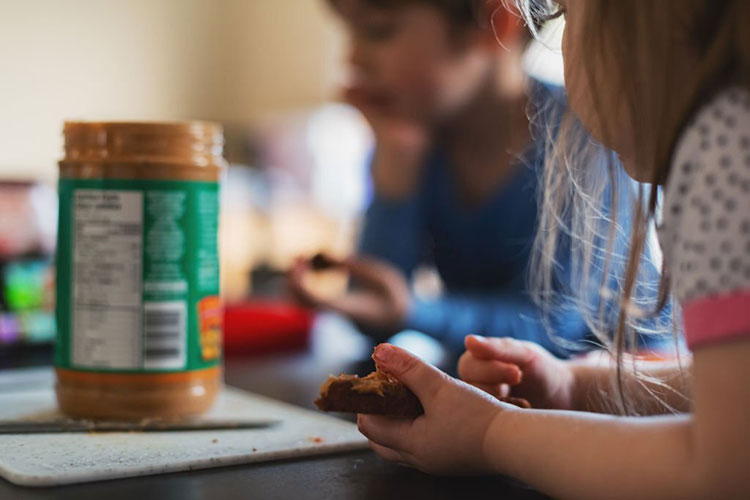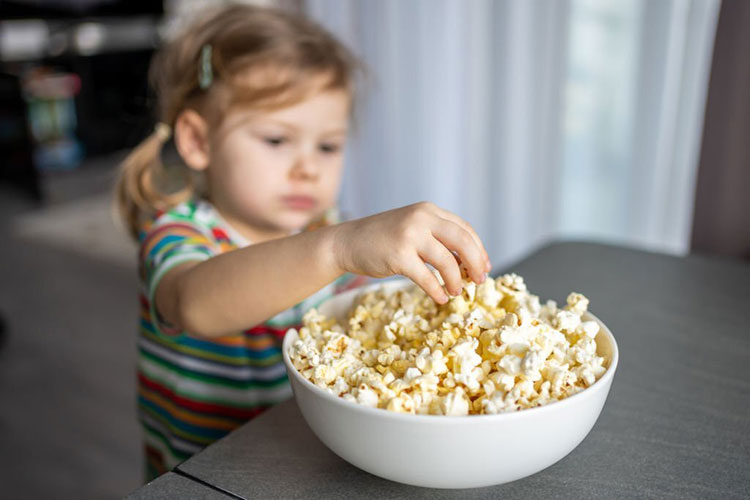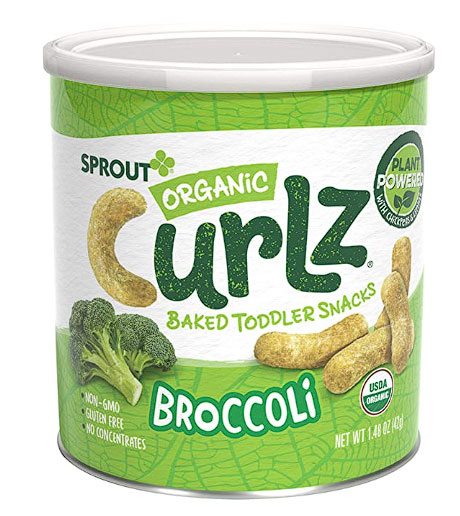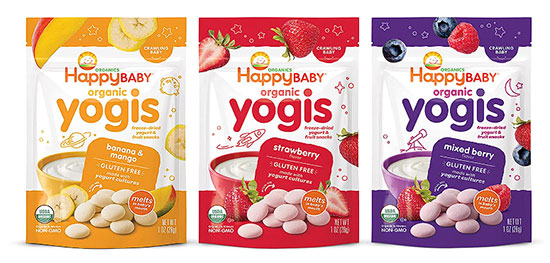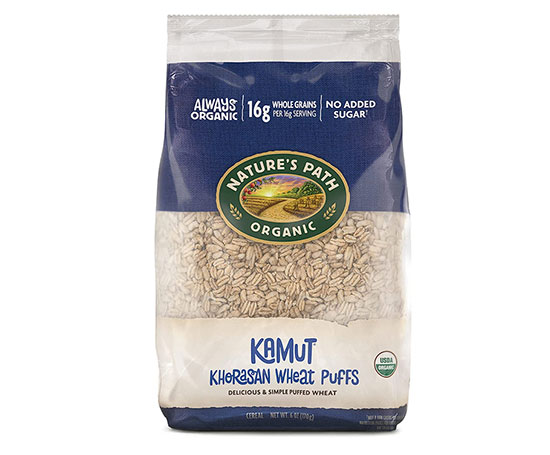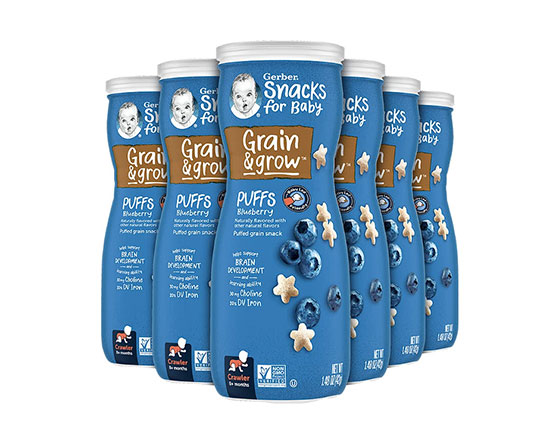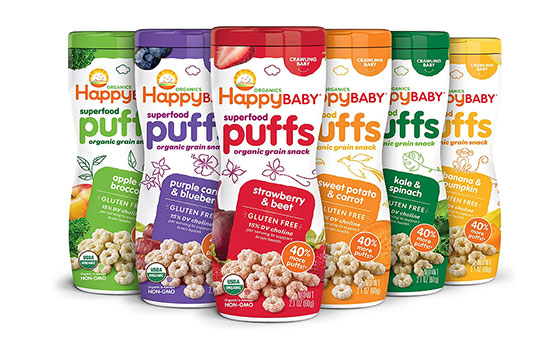When your baby is happily gumming down a mouthful of puffs, it can be hard not to smile. But then comes that nagging worry in the back of your mind–is this really safe? You’ve heard stories about babies choking on these popular little snacks, and you can’t help but wonder: Can babies choke on puffs?
Fear not! We’re here to answer this common question every parent has about giving those delicious and seemingly harmless snacks. Keep reading for the facts on safety surrounding puffs and peace of mind!
What are puffs for babies:
Puffs are a yummy snack to share with your baby as they’re trying out solid foods! With fun, colorful shapes that easily dissolve in their mouth, puffs make perfect handheld snacks for when you’re on the go. They come in all sorts of flavors and contain different combinations of ingredients – from traditional grain-based recipes to gluten-free alternatives. Regardless of which type you choose, rest assured it’ll be one tasty treat!
As babies grow, they need to learn the invaluable skill of feeding themselves. Puffs are an excellent snack for those early developmental stages and help toddlers gain fine motor skills. According to Nicole Silber -an expert registered dietitian, these easily dissolvable finger foods are designed to help them sharpen their oral motor skills, get the hang of using their tiny fingers in a precision grasp and even work on hand-to-mouth coordination.
Here is a discussion by Nicole Silber, RD., CSP., CLC on the introduction of solids for your babies.
When can babies have a puff?
Most babies are headed toward solids around 6 months of age, but there are some signs that the baby has graduated to the puff-eating club. Is your baby interested in what you’re eating? Do they munch up and down while watching you eat? Have they been able to sit independently, with strong neck control and no tongue thrust reflex? If so, your little one may be ready for puffs or other finger foods! But don’t be afraid to check in with your pediatrician if you’re unsure – they’ll be glad to help ease any anxiety.
What is choking in babies:
Choking in babies is when a baby cannot breathe because food or any other object blocks their throat or airway.
Signs of a baby choking
- The baby may start to make high-pitched noises when they breathe.
- The baby may face difficulty in breathing.
- The baby may not be able to cry or speak.
- The baby may have a bluish tint to their skin and lips.
- The baby may become unresponsive or disoriented.
- The baby may become unconscious.
- The baby may hold their throat and wave their arms.
- The baby may become distressed and agitated.
- The baby may start to gag and cough.
Can babies choke on puffs?
When it comes to Puffs, parents are often concerned about choking hazards. However, with their air-filled composition and tendency to dissolve quickly in the mouth, there is really very little risk of your baby choking on them. To keep things extra safe, always pair a few puffs with some sips of liquid – this will help any food that sticks in her mouth move around efficiently and prevent any potential problems. Of course, only offer these foods when your baby is ready for solids to begin with. Additionally, if you’re feeding Puffs that have been open or out for a while they may not dissolve as easily as fresh ones and could present a greater risk – so avoid leaving them sitting around for too long!
What can be done to avoid your baby choking on puffs:
Make sure the puffs are fresh:
When feeding your baby puffs, freshness is key. Puffs that have been out for an extended period of time lose their meltability and become squishy in texture, presenting a choking hazard for your baby. Throwing away the puffs that have been sitting in the snack bowl or tray for too long is the best route to take—fresh ones will always make sure your little one can enjoy them safely!
Keep water nearby:
For your baby’s safety, always keep a drink handy when feeding them soft snacks such as puffs. A sip of liquid can help to move any food that may get stuck in their mouth more easily and safely.
Limit the amount of puffs your children put in their mouth at once:
For your toddler’s safety, it is important to monitor how much puffs you offer at once and refill the tray or bowl regularly. Too many puffs in one go can cause choking in babies and toddlers, so be sure to keep an eye on their portion size!

Watch out for any signs of choking:
Keep an eye out for any signs of distress when your little one tucks into Puffs and other first finger foods – it’s essential to ensure their safety while they explore the world through taste!
Wet your puffs:
If you’re looking for that extra bit of reassurance when feeding your baby puffs, some parents suggest lightly wetting the snack to ensure they are soft and dissolve easily in order to avoid choking.

Crush your puffs or break them into half:
Some parents took a unique approach to keep their little ones safe and sound from choking. They’d crush up puffs into tiny morsels between their fingers before giving them to the children, eliminating any risk of choking hazard! Some parents deftly divide puffs in two so their little ones can happily enjoy them without the risk of choking.

Never use your fingers to remove puffs from your baby’s throat:
Don’t even think about using your fingers to fish out puffs from a baby’s throat – it can lead to more trouble than you may have bargained for.

Is your baby choking on puffs or he/she is just gagging?
When your baby is trying to eat their puffs and you see them struggling with some kind of discomfort, it can be quite worrisome! Your first instinct may be to think that he or she is choking and start to panic. But is it really choking or just gagging? Knowing the difference between choking and gagging can be the difference between a quick, embarrassing moment, and a life-threatening emergency.
Even though the difference between the two can sometimes be hard to tell, there are a few key things that you should look out for. Gagging usually involves sputtering, coughing, and retching noises with their face may turn red and eyes may water but the airway remains clear. In contrast, when a baby is choking the airway is blocked or partially blocked, and this may result in their face or lips turning blue or purple – with them being shockingly quiet! Paying attention to these signs will help you respond quickly and calmly in the event of an emergency.
Here is a discussion by Dr. Phil Boucher on ” Choking vs Gagging”
The Study- “Chew on This: Not All Products Labeled First Finger Foods are Created Equal,”
In a study conducted by Cohen Children’s Medical Center in New York, researchers took a closer look at different pre-packaged products marketed as baby finger foods. Nine products from various food groups – melts, cooked produce, puffed grain products, biscuits, and cereals were subjected to testing. During this experiment, eleven participants were blindly given each food item and asked to deem it safe to eat without the use of teeth by gauging how fast the food could dissolve without effort. To ensure an accurate reading of the results, subjects are required to taste the product twice when it is fresh and two more times after being left out for an hour. What’s interesting about this trial is that it allows for a better understanding of exactly which types of finger foods are safe for children to consume as they start their journey to eating solid foods.
Analyzing several varieties of products, researchers determined Gerber Graduates Fruit and Veggie Pick-ups were the only ones to meet their stringent criteria. Grain-based products, such as Cheerios and Gerber Graduates Puffs, did not stand up to all criteria, however- they were praised for their quick dissolution characteristics.
The lead investigator Nicol Awadalla, M.D. has identified multiple concerning aspects regarding four of the nine products that were tested. Not only did they possess a choking hazard, but two of them took an exceedingly long time to dissolve after they left the packaging – posing potential further health risks. These findings have indicated the need for greater analysis and further quality control measures to ensure that products meet standard safety regulations.
Researchers have identified a need for more research to classify the many types of baby finger foods on the market and distinguish between those that are developmentally appropriate. Researchers have determined that though crawling appears to emerge around 6-10 months of age, it is not an accurate indicator of whether a baby may be ready to eat finger foods. Contrary to popular belief, this milestone has few connections with oral motor skills and thus should not be used as the sole indication of when food other than purees can safely begin.
Resource Taken from: https://pubmed.ncbi.nlm.nih.gov/28990427/
Why do parents love baby puffs:
Baby Puffs are a parent’s best friend! Not only are they super convenient for on-the-go snacking, but they are also incredibly beneficial for teaching babies how to chew and how to use the famous pincer grasp for picking up their own food. With their easy dissolving texture you can relax knowing that there is minimal risk of choking with this tasty first finger food. To top it off, Baby Puffs come in fun shapes and delicious flavors making mealtime exciting for both parents and little ones alike!
Nutritional benefits of baby puffs:
Baby puffs may not seem like nutritional powerhouses, but it’s far from being nutritionally bankrupt. These snacks consist mainly of air but, depending on which brand you opt for and what ingredients are used in their creation, these fluffy treats can be a worthwhile source of vitamins and minerals! Of course, carbohydrates form the main macronutrient making up baby puff snacks; providing your little one with much-needed energy.
How to prepare for choking emergencies
A choking emergency can put any parent on edge. But being prepared is key to making sure it doesn’t become a life-altering scenario! Signing up for first aid and CPR courses through the American Heart Association, Red Cross or local hospital will provide you with valuable safety training so that you’re equipped if an incident does occur. With knowledge comes power, and knowing how to respond quickly and properly during a choking emergency may mean the difference between tragedy and relief. So make sure you’re prepared – your child’s life could depend on it!
Top choking foods for babies
They may be small, but babies can surely put away a lot of food! From mashed potatoes and oatmeal to fruits and veggies – you name it, your little one hasn’t met a snack they don’t like. But as parents, we know safety always comes first when feeding our children. And that means being aware of certain “choking hazards,” or foods that are more likely to get stuck in their throat if not properly cut up. So here we’re diving into some common choking foods for babies – the ones that have even experienced parents pausing in fear before plopping them down on those tiny plates!
While bread:
While bread may be a regular breakfast in many households, few would consider it to be one of the deadliest hazards for infants. Unfortunately, its pasty texture can easily become lodged and block the airway – leaving tiny tikes gasping for breath! Parents should steer clear of giving small babies this food item until they are confident that their child won’t choke when eating chewy items like bread.
Yogurt melts:
At first glance, yogurt melts may seem like the perfect finger food for babies since it softly dissolves in their delicate mouths. However, not enough attention is paid to how long these treats are left out exposed to air – a fatal mistake! After spending too much time outside of its packaging, this treat can turn into a potential choking hazard due to its ability to change from melt-in-your-mouth goodness and become lodged in your precious one’s throat. Be vigilant with safety measures when feeding your little ones; you never know if something as seemingly harmless as yogurt melts could be dangerous instead!
Read: Baby Rolling in Crib Hitting Head – What You Can Do?
Nuts and seeds:
If you have a little one in the house, it’s time to play detective – spot and avoid any hazards that could cause choking! Nuts and seeds are not suitable for children who haven’t yet developed their molars; these hard snacks can be difficult to chew properly. When it comes to dry fruits, choose wisely: opt for spreadable versions as opposed to whole nuts or sharp-edged items like almonds, peanuts, or cashews which pose an extra risk of endangerment. Play safe, parents – your baby’s safety is paramount!
Peanut butter:
While the creamy concoction of peanut butter might make for a delicious meal or snack, it can prove especially hazardous for babies as it sticks to the throat, making it nearly impossible to pass through by itself. This goes not just for actual peanut butter but other nut butter as well! So while little ones may be entranced with all sorts of delectable delights, it’s important to remember that some foods can have serious implications if underestimated by their parents and caregivers.
Crackers or rice cakes:
When hunger calls, it is hard to resist the temptation of handing your little one anything that seems like a good snack. But before you give them crackers or rice cakes, keep in mind they can be potential choking hazards! These coarse-textured and usually dry foods are challenging for babies to break down smoothly- so feed with caution!
Cheerios:
If you’ve got a baby, Cheerios are likely a staple in your cupboard. They’re the ideal first food for young children – easy to mush into tiny pieces and dissolve when exposed to saliva! But beware of overloading on these o-shaped snacks – if too many are crammed into little mouths at once, they can become a choking hazard. So always keep an eye on bubba when they’re munching on their cereal snack.
Raw vegetables:
As any new parent knows, there is a long list of ‘dos and don’ts; to wade through when caring for your little bundle of joy. One subject that doesn’t often get much airtime is the topic of raw vegetables and babies. While they can make an incredibly nutritious snack for older children, raw vegetables can be a choking hazard for babies and toddlers as they are difficult to chew and swallow. Parents should opt for cooked or pureed vegetables instead until their baby is old enough to safely eat solid foods. If you have recently welcomed home a bundle of love, remember: no matter how tempting it might be to give them something fresh from the garden, it’s best to err on the side of caution…unless you want your baby’s first words to be “911!”
Popcorn:
Popcorn is an ever-present, yet dangerous threat to babies everywhere! This snack may seem harmless at first glance but its hard and crunchy texture renders it one of the greatest choking hazards. Unpopped kernels can easily get stuck in your tot’s throat blocking their airway – a scary thought indeed. so keep young kids away from those tempting morsels of salty goodness!
Grapes:
Did you know that a seemingly innocent item like grapes can be a choking hazard for babies? That’s right! The shape and size of grapes mean that they can easily get wedged in an infant’s delicate airways, leading to a terrifying medical emergency. So next time before popping a grape onto your baby’s plate, just think to yourself: Is it worth risking the child’s safety for this delicious treat?
Read: BABY FLAILING ARMS AND LEGS WHILE SLEEPING
Hard candies:
Hard candies like candy, gummy candy, and toffee may seem innocent enough, but they can be a real hazard. Babies don’t have the capability to suck yet, so even if they try to put it in their mouth they could inadvertently swallow the entire candy which poses a potential danger. So make sure you steer clear of hazardous items when feeding your little ones!
Chunks of cheese and meat:
Feeding babies solid food can be a daunting experience for parents, especially when chunks of cheese and meat are involved. After all, these cubed foods may seem small enough to shove down little throats without much worry — but be warned! Experts caution that cheese and meat can create a serious choking hazard for infants. Those squishy cubes might seem harmless…but have you ever seen the size of a baby’s windpipe? A lump of cheese or cube of ham could easily become lodged in there, possibly blocking your child from taking in vital oxygen. Better safe than sorry — always make sure to dice those solids into tiny pieces for your picky eater.
Best baby puffs:
Welcome on a quest with us through all your options as we guide you toward selecting the best baby puffs out there. Puffed snacks aren’t just fun and delicious: they’re also an important part of your baby’s healthy diet. From organic options to lower-cost alternatives, we’ll give you the most comprehensive scoop on which ones will grow your little one stronger (and tastier). There’s no time like now; so let’s get puffing!
1. Sprout Organic Curlz Toddler Snacks:
If you thought that a snack for toddlers had to be boring and predictable, we have great news for you: Sprout Organic Curlz Toddler Snacks have arrived to bring good taste, organic nutrition, and loads of fun (not to mention awards) into meal times! Made in three yummy flavors – Broccoli, White Cheddar, and Sweet Potato & Cinnamon – these tasty curls are USDA Certified Organic, Non-GMO, and contain nothing artificial. They’re also gluten-free, dairy-free, vegan, and don’t even have added flavors or colors! Plant-powered by organic chickpeas and lentils baked with savory broccoli then preserved only with organic rosemary (don’t worry – it won’t affect the flavor!), these snacks were such an instant hit they were awarded the National Parenting Product Award as well as Delicious Living’s Best Bite Award. Now that’s worth celebrating!
2. Gerber Snacks for Baby Teethers, Organic Gentle Teething Wafers:
Tired of hours spent rocking and humming lullabies to your teething baby? Look no further than Gerber Snacks for Baby Teethers, Organic Gentle Teething Wafers! Instead of soothing gums with a toy or your finger, this delicious snack provides the perfect food-based solution for babies seven months or more.
With an easy-to-grip design, not only your little one will start learning self-feeding– your little one will also get 4 grams of whole grains and 2 grams of protein with every serving. Plus, all the ingredients are non-GMO and Certified Organic; so worry less about artificial flavors, colors, or preservatives. Also enjoy wholesome ingredients like whole grains, yogurt, & real fruit & veggies! So give those lullabies a rest and start stocking up on Organic Gentle Teething Wafers: they might just save your sanity!
3. Happy Baby Organics Yogis Freeze-Dried Yogurt & Fruit Snacks:
If your baby is ready to take the next step, Happy Baby Organics Yogis Freeze-Dried Yogurt & Fruit Snacks are here to help! These tasty treats provide the perfect introduction for your crawling cutie to explore the wonderful world of solid foods. Crafted with 5 delicious flavors, including Banana Mango, Blueberry Purple Carrot, and Mixed Berry, these snacks are USDA-certified organic and Non-GMO with no toxins or additives whatsoever. Moist and full of flavor, each bite contains wholesome yogurt blended with nutritious organic fruit and is lovingly sealed in packaging sans BPA, BPS, and other troublesome phthalates. Let your little one’s first adventure into food exploration with Happy Baby Organics Yogis Freeze-Dried Yogurt & Fruit Snacks be as sweet as can be!
4. Baby Bellies Organic Lentil Wheels, Beetroot & Strawberry:
Baby Bellies Organic Multigrain Baby Snacks are truly a snack like no other! Baked, not fried, these organic lentil and corn goodies are sprinkled with added beetroot and strawberry for just that extra bit of deliciousness. Perfectly designed to support the natural progression of your child while encouraging the development of both palate and motor skills. These amazing snacks come for two separate age levels – 7+ months (Tasty Textures) and 10+ months (More to Explore). Best of all, their unique shapes make them great for little hands to hold easily . and last but not least, you can have peace of mind knowing that these snacks are EU Organic certified and USDA Organic certified! Let your baby try Baby Bellies today for snacking without worry!
5. Earth’s Best Organic Kids Snacks
Forget about boring snacks—Earth’s Best Organic Kids Snacks will have your children smiling while they crunch! Decked out with playful Sesame Street characters and featuring only five USDA-certified organic ingredients, these Gluten Free snacks have already earned their place in the hearts of parents and kids alike. Each bite brings a burst of delicious flavor and a satisfyingly crunchy texture. So the next time snacks are on your mind, reach for Earth’s Best Organic Kids Snacks and bring delight to snack-time.
6. Sprout Organic Baby Food Baby Snacks Plant Power Puffs:
Sprout Organic Baby Food has done it again! Introducing Plant Power Puffs, the ultimate snack made with real ingredients and bursting with flavor. With no added sugar, artificial flavors or colors, Preservatives, or GMOs – you can rest assured that your baby is tasting nothing but pure deliciousness. They come in three yummy varieties: Carrot Mango, Apple Kale, and Maple Cinnamon. Not to mention they are made with 4 grams of whole grains and a blend of fruits & vegetables which provides an excellent source of vitamins A & C for your little one.
With each puff being soft enough to dissolve in your baby’s mouth yet the perfect size for their learning fingers to self-feed – this organic snack packs everything you need into a wholesome treat! It’s no wonder Sprout Organic Baby Food Baby Snacks have been recognized by the National Parenting Product Awards. Paired with their 100% BPA-Free and Recyclable packaging… you won’t find a safer or tastier snack for your little one! Pop open a canister today and let this product tantalize your tyke’s taste buds!
7. Plum Organics Super Puffs Variety Pack:
Introducing PlumOrganics SuperPuffs Variety Pack – the perfect pick-me-up snack for little tots, and teethers! Tailored with an unyielding commitment to quality, this package comes complete with 7 vitamins and minerals and only organic, non-GMO ingredients. Plus, each flavor is dated based on its own unique blend of ingredients so that your guy or gal can get the most out of each bite. And best of all? Say goodbye to artificial flavors and sweeteners – this tasty treat is USDA-certified, Kosher, and as convenient as it gets thanks to its 100% BPA-free packaging which also fits snugly in cup holders. So why not give your tot the premium puffed-up treat they deserve? With Plum Organics SuperPuffs Variety Pack you get the best of taste and nutrition…guaranteed!
8. Nature’s Path Organic Kamut Puffs Cereal:
Nature’s Path Organic Kamut Puffs Cereal is certainly designed with food-conscious consumers in mind! Not only is the cereal made with organic, whole grain Kamut Khorasan wheat kernels that are air popped for a delicately crispy texture, but it also contains no added sugar and is certified as USDA organic, Kosher, and vegan. For even more eco-friendliness points, Nature’s Path uses 66% less packaging than a cardboard box with their recyclable Ecopac bags- talk about earth-friendly initiatives.! With its non-GMO Project verified ingredients and no artificial flavors or preservatives, Nature’s Path Organic Kamut Puffs make a deliciously nutritious breakfast worthy of an ovation!
9. Gerber Baby Snacks Puffs:
Gerber Snacks Puffs make checking off the snack box on your to-do list easier than ever. This snack is the perfect size for mastering those chubby little fingers and is even easier to chew and swallow. More impressive than that though is what’s inside each bite – a whopping 2 grams of whole grains per serving with an added bonus of five essential vitamins and minerals. No need to worry because Gerber takes pride in ensuring that all of its ingredients are NON-GMO, and have no artificial flavors or sweeteners. And just for fun, for parents looking for exciting snack-time flavors, there are eight yummy varieties to choose from – Apple Cinnamon, Banana, Banana & Strawberry, Blueberry, Peach, Sweet Potato, Vanilla, and Strawberry Apple. With this much fun on the plate, it’s sure to be a snack hit!
10. Happy Baby Organics Superfood Puffs:
Happy Baby Organics Superfood Puffs are the snack you didn’t know you needed in your life. With seven unique flavor combinations fortified with choline for eye and brain health that melt in your baby’s mouth, these puffs won’t fly off your grocery shelves. But why stop there? They’re certified USDA organic, made with non-GMO ingredients, and the packaging is free of any suspicious BPA, BPS, or phthalates. Plus, it’s a great way to introduce solid food to babies when they can crawl on their hands and knees without their tummy touching the ground! So why not take a step back from those other snacks and try something new? Get your superfood puffs today!
Tips for feeding puff:
It’s no secret that when it comes to feeding your baby, there is a lot of information out there. But one thing that is often overlooked is the tips and tricks that make feeding your little one easier and more fun. We’re here to help – so we put together a list of baby puff feeding tips to make mealtime with your little one a breeze.
Serve a small amount:
Little puffs are a fun and easy way to introduce self-feeding—but it’s important not to let your baby get carried away! To avoid any potential messes and choking hazards, serve only small handfuls of these bite-sized treats at once, so they don’t end up getting overstuffed. Helping them learn how much is too much makes learning the art (and science!) of snacking all the more enjoyable for everyone involved.
Introduce variation:
Satisfy baby’s taste buds and guarantee proper nutrition with a mix-and-match approach to puffs! Take your pick from naturally delicious flavors, each offering something special in terms of nutrients that growing bodies need. Be sure to vary the types you buy for an exciting journey through flavor town every snack time.
Switch up brands:
Feed your little one a rainbow of puffs! Not only does this provide much-needed variety for growing taste buds, but it also helps reduce the potential exposure to heavy metals from rice-based snacks. With so many options available in today’s marketplace, you can easily switch up brands and textures – giving your baby the best nourishment while creating an ever-rotating menu they’ll love.
Read: HOW TO FIX ASYMMETRICAL CRAWLING
Zero Sugar:
If you’re in the market for puffs, ditch those with added sugar and look towards healthier options! Your little ones will thank you when they reap the nutritional benefits.
Don’t get too reliant on puffs:
Mealtime with your little one should be an exciting adventure, full of variety and loads of nutrition! That’s why it’s important that you don’t get too reliant on puffs for sustenance – after all, they make a great snack… but not every time. So team them up with other mouth-watering munchies to create the perfect balanced meal – ensuring your baby will explore different flavors while getting enough nutrients at the same time!
Softening the puffs:
Feeding your little one just got easier! Make the transition from bottle to solid foods a breeze by softening puffs with delicious breastmilk or formula and gently spoon-feeding them directly into the baby’s mouth. Bon appétit!
Crush the puffs:
crush puffs into a fine powder and then use them to give an added layer of crunch to softer fruits or veggies, like an avocado slice. And voila – deliciousness made easy!
Puffs won’t keep your baby full for a long:
Though baby puffs may look deceptively filling, they’re really just fluff! Don’t overestimate their hunger-quelling power – a few won’t keep your little one feeling full for long.
Gluten and dairy-free:
When searching for puffs, ensure to keep an eye out for gluten-free and dairy-free options. With so many choices available, you’ll have no trouble satisfying those hunger pangs in a healthy and nutritious way.
Watch out:
Though puffs dissolve quickly in your child’s mouth, mealtime should always be taken seriously. Ensure that when serving them you’re monitoring the situation and ready to act fast if any signs of choking arise!
How to keep puff fresh:
Puffs might look inviting when you grab them off the shelf, but if your snack doesn’t make it to consumption in a timely manner they can become stale and soft.In addition, humid weather can be particularly unkind to snackers as well. To prevent this from happening, be sure to store your puffs in an airtight container – think mason jar with a good lid! This will keep their freshness intact for longer so that all of those tasty snacks actually live up to expectations.
Despite the fear that some parents might experience when feeding their little one puffs, we can happily report it’s safer than many people think. First, puffs are air-filled and dissolve quickly in the mouth, so there’s very little risk of your baby choking on them as long as you use fresh puffs. Second, monitoring your baby while they are eating is always recommended. Keep a cup of water close by and if needed, wet the puff and break it into smaller pieces before giving it to baby. Feeding puffs doesn’t have to be a scary task and parents can have peace of mind knowing




